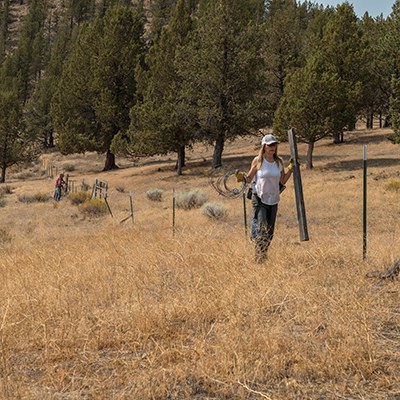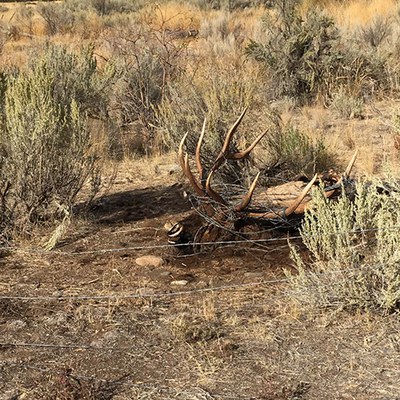By Peter Cooper
Content warning: this blog post contains vivid imagery.
Central and Eastern Oregon are chock full of open landscapes that are crisscrossed by barbed wire fencing. Typically used as a means to keep livestock contained in a particular area, barbed wire fences have been constructed since Euro-Americans began seeking livelihoods in the West more than a century ago. According to National Geographic, it is estimated that there is roughly 600,000 miles of fencing in the American West—which is enough to wrap around the earth 24 times! While fencing is an integral part of raising livestock and managing land, the effects on wild animals such as deer, elk, pronghorn, raptors, and other species often goes unnoticed.
Why are fences such a barrier for wildlife? In general, fences become hazardous when they are too high to jump over, too low to crawl under, have loose wires, have wires that are too close together, and are difficult for fast moving animals to see. According to the Natural Resources Conservation Service (NRCS), most fatalities occur when animals get caught in the top two wires trying to jump the fence. This is why spacing and total fence height are such important factors. Furthermore, diving raptors and other low-flying bird species will often collide with fencing because they can’t see it. Unfortunately, the Land Trust has witnessed firsthand what can happen when a fence encounter goes wrong. The picture below shows a bull elk that got its antlers tangled in a barbed wire fence on one of the Land Trust Preserves and sadly died as a result.
If fencing is required for livestock, boundary enforcement, or any other use, the second option is to retrofit or replace traditional barbed wire fences with a wildlife-friendly version. If you are a landowner and would like to replace your traditional barbed wire fences, NRCS may have grants available through the Environmental Quality Incentives Program (EQIP). The first step is talking to your local NRCS office. Otherwise, as you fix and replace fencing, you can consider converting it to wildlife-friendly fencing.
The NRCS provides details on what a wildlife friendly fence might look like. The general specifications from state wildlife agencies to consider when building a more wildlife-friendly fence are as follows:
- Smooth top and bottom wire
- No more than 42 inches tall
- 12 inches between top two wires
- 18 inches between bottom wire and the ground
- 16 feet between posts
- Visibility markers if possible
Through barbed wire removal and/or the adoption of wildlife-friendly fence alternatives, we can all help create conditions that ensure wild animals can move more freely throughout their historic range. It wasn’t that long ago when there were no fences at all, and, although they are a necessary part to many ways of life, we can still work together to help care for the land and make life a little easier for local wildlife.
Sources:
- In Wyoming, fences are coming down to make way for wildlife, National Geographic
- How Mending Fences Makes a Difference for Migrating Big Game, Theodore Roosevelt Conservation Partnership
- A Landowner's Guide to Wildlife Friendly Fences: How to Build Fence with Wildlife in Mind, NRCS
- Wildlife Friendly Fencing, Think Wild
Learn more:
- Guidebook to Wildlife Friendly Fencing
- NRCS Environmental Quality Incentives Program
- The Speedy and Impressive Pronghorn
- Herd Nerd: All About Elk


